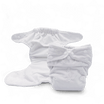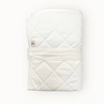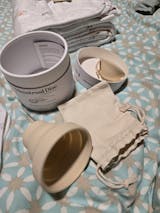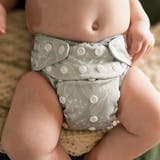Cloth nappies are a fantastic eco-friendly choice for many parents, offering a sustainable and cost-effective alternative to disposables. However, one common concern for new users is dealing with nappy leaks. Understanding the reasons behind these leaks and how to address them can help you maintain a reliable and leak-free cloth nappy routine. In this blog, we’ll explore the common causes of cloth nappy leaks and provide practical solutions to keep your baby comfortable and dry.
1. Flooding: What It Means and How to Manage It
Understanding Flooding
Flooding occurs when the absorbent materials in a cloth nappy are overwhelmed by the volume of liquid, causing leaks. This often happens when a nappy isn’t absorbing quickly enough or when the baby produces more urine than the nappy can handle.
Causes of Flooding
- Inadequate Absorbency
- Incorrect Nappy Type
- Overloading
Solutions to Prevent Flooding
- Choose the Right Nappy Type
- Use Appropriate Boosters
- Regular Changes
- Add a Cotton Face Washer
Placing a cotton face washer between your baby and the nappy can help manage flooding. The face washer provides an extra layer of absorbency and gives the inserts more time to soak up the liquid, reducing the likelihood of leaks.

2. Poor Fit and Leakage

Why Fit Matters
A proper fit is crucial for preventing leaks. Nappies that are too loose or too tight can cause gaps or compression leaks, where the liquid escapes from the sides or the back of the nappy.
Causes of Poor Fit
- Incorrect Sizing
- Improper Adjustment
Solutions for a Better Fit
- Check Sizing
- Adjust Properly
3. Incorrect Nappy Assembly
Understanding Nappy Assembly
Cloth nappies often require proper assembly before use. Incorrectly assembling the nappy, such as misplacing inserts or not using the correct type of insert, can lead to leaks.
Common Assembly Issues
- Misplaced Inserts
- Wrong Combination
Solutions for Proper Assembly
- Follow Instructions: Refer to the brands guidelines for assembling and using the nappy correctly.
- Use Compatible Inserts: Ensure that any additional inserts or boosters are suitable for your specific nappy type.

4. Build-Up of Residues
What is Build-Up?
Build-up of detergent, fabric softeners, or other residues on cloth nappies can reduce their absorbency and cause leaks. Residue build-up can occur from improper washing routines or using inappropriate laundry products.
Causes of Residue Build-Up
- Overuse of Detergents: Using too much detergent can leave residues on nappies, affecting their ability to absorb liquid.
- Fabric Softeners: Fabric softeners can coat the fibres of cloth nappies, reducing their absorbency and effectiveness.
Solutions to Prevent Build-Up
- Use the Right Detergent
- Avoid Fabric Softeners
- Strip Wash
5. Inadequate Washing Routine
Importance of Proper Washing
An effective washing routine is essential for maintaining the performance of cloth nappies. Inadequate washing can lead to a decrease in absorbency and increased likelihood of leaks.
Common Washing Issues
- Insufficient Rinsing
- Inappropriate Washing Temperatures
Solutions for an Effective Washing Routine
- Follow Washing Instructions: Adhere to the manufacturer’s washing guidelines for temperature and cycle settings.
- Rinse Thoroughly: Ensure nappies are well-rinsed to remove all detergent residues.

Understanding the common reasons behind cloth nappy leaks and implementing the right solutions can help you maintain a leak-free and comfortable experience for your baby. By choosing the right nappy types, ensuring a proper fit, correctly assembling your nappies, preventing build-up of residues, and following an effective washing routine, you can enjoy the benefits of cloth nappies with confidence. For more tips and high-quality cloth nappy options, explore Mimi & Co’s range of products designed to meet your needs and ensure a reliable nappy routine.



![Swim Nappy Bundle [Ship Oct 5 - 10] - Mimi & Co](http://mimiandco.com.au/cdn/shop/files/swim-nappy-bundle-ship-oct-5-10-5796576.jpg?v=1761125410)

![Toilet Training Undies Pants [Jan Preorder] - Mimi & Co](http://mimiandco.com.au/cdn/shop/files/toilet-training-undies-pants-jan-preorder-6316642.jpg?v=1766216229&width=1200)
![Reusable Bamboo Mimi™ Wipes [5 Pack] - Mimi & Co](http://mimiandco.com.au/cdn/shop/files/reusable-bamboo-mimi-wipes-5-pack-7600782.jpg?v=1761445103)




![Reusable Mimi® Menstrual Underwear [Shipping 31/9] - Mimi & Co](http://mimiandco.com.au/cdn/shop/files/reusable-mimi-menstrual-underwear-shipping-319-6508918.png?v=1759809525)







![One Size Fits Most Preflat [PreOrder] - Mimi & Co](http://mimiandco.com.au/cdn/shop/files/one-size-fits-most-preflat-preorder-761880.webp?v=1759809321&width=104)



![Toilet Training Undies Pants [Jan Preorder] - Mimi & Co](http://mimiandco.com.au/cdn/shop/files/toilet-training-undies-pants-jan-preorder-6316642.jpg?v=1766216229&width=104)













![Reusable Bamboo Wipes [5 Pack] - Mimi & Co](http://mimiandco.com.au/cdn/shop/files/reusable-bamboo-wipes-5-pack-580411.webp?v=1764820089&width=104)
![Organic Cotton Wipes [5 Pack] - Mimi & Co](http://mimiandco.com.au/cdn/shop/files/organic-cotton-wipes-5-pack-7079645.png?v=1759809401&width=104)





![Reusable Mimi® Menstrual Underwear [Shipping 31/9] - Mimi & Co](http://mimiandco.com.au/cdn/shop/files/reusable-mimi-menstrual-underwear-shipping-319-6508918.png?v=1759809525&width=104)





















Leave a comment
All comments are moderated before being published.
This site is protected by hCaptcha and the hCaptcha Privacy Policy and Terms of Service apply.